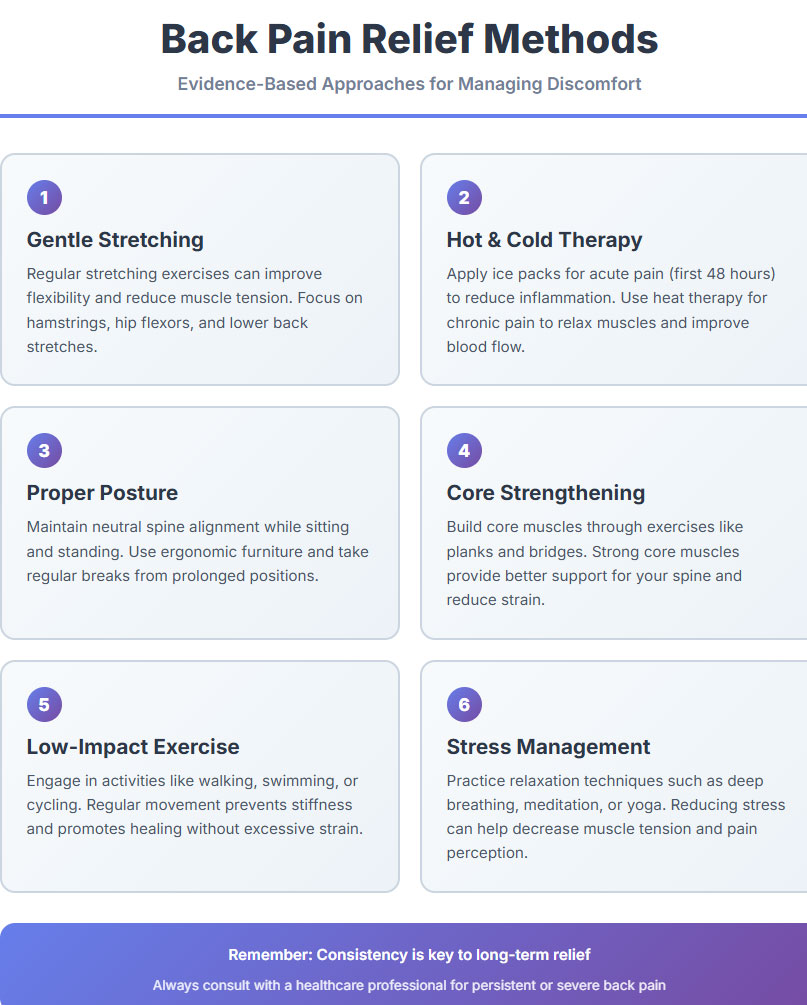Lower back pain remains one of Canada’s most common health concerns, affecting workers, athletes, and seniors alike. Treatments range from quick‑relief options.such as cold or hot compresses, over‑the‑counter pain relievers, and gentle stretches to structured, long‑term strategies. Physiotherapy, core‑strengthening programs, and Pilates are proven to improve flexibility and reduce pain recurrence. For persistent or severe cases, spinal manipulation therapy (SMT), acupuncture, and targeted injections (including corticosteroids) may offer lasting relief. Modern approaches often blend conventional medicine with complementary care, emphasizing tailored plans based on medical imaging and physical assessment. Preventive measures .like proper posture, ergonomic workstations, and regular low‑impact exercise.remain critical for avoiding flare‑ups. While surgery is considered a last resort, most Canadians can manage lower back pain effectively with early diagnosis, multidisciplinary treatment, and lifestyle adjustments. The right intervention, at the right time, can mean the difference between chronic discomfort and a healthy, active life.
WHAT WILL YOU READ…
Understanding Back Pain
Back pain is far more than a minor inconvenience. Across Canada, it ranks among the top reasons for missed work and healthcare visits. Lower back pain can stem from structural changes in the spine, injuries, or underlying medical conditions, and it often worsens without timely care. Early intervention is vital.it not only reduces current discomfort but also prevents the pain from turning chronic, which is harder to manage and more likely to impact mobility. Treatment options range from simple home measures to advanced physiotherapy and targeted medical procedures. Recognizing symptoms early, consulting healthcare professionals, and adopting preventive habits like exercise and proper posture are essential strategies. Canadians who prioritize treatment often recover faster, avoid long‑term disability, and maintain an active lifestyle, protecting both physical and mental well‑being in the long run.
Impact of Back Pain on Daily Activities
Living with back pain affects more than just physical comfort.it influences every aspect of daily life. In Canada, people with persistent pain often limit their work hours, avoid social events, or reduce recreational activities. Tasks like bending, lifting, and even prolonged sitting become challenging, leading to frustration and decreased productivity. Chronic pain can drain mental energy, triggering stress, anxiety, or depression. Sleep quality frequently suffers, which further impacts overall health. Active parents may struggle with childcare responsibilities, while older adults risk losing independence due to reduced mobility. The economic impact is notable, from missed workdays to medical costs. Addressing back pain promptly through effective treatment and lifestyle adjustments helps restore normal function, enabling individuals to return to work, enjoy leisure, and participate fully in community life.critical factors in maintaining a balanced, fulfilling Canadian lifestyle.
types of back pain
| Type of Back Pain | Common Causes | Typical Impact |
|---|---|---|
| Acute back pain | Muscle strain, ligament sprain, sudden injury | Sharp pain, temporary reduced mobility |
| Sub‑acute back pain | Unresolved injury, mild disc issues | Persistent discomfort, moderate activity limits |
| Chronic back pain | Degenerative disc disease, arthritis, nerve damage | Ongoing pain, long‑term mobility challenges |
| Radicular pain (sciatica) | Nerve root compression, herniated disc | Shooting pain down the leg, numbness or tingling |
| Mechanical back pain | Poor posture, repetitive strain, ergonomics | Localized pain, worsens with movement |
| Inflammatory back pain | Autoimmune disease, ankylosing spondylitis | Morning stiffness, improves with activity |
Diagnosis
Accurate diagnosis of back pain is essential for ensuring effective treatment and preventing long‑term complications. In Canada, clinicians adopt a step‑by‑step approach, starting with patient interviews and physical examinations, followed by targeted testing. Back pain may result from muscular injury, degenerative spine changes, nerve compression, or systemic disease, and each requires different management. Early and precise diagnosis allows Canadian healthcare professionals to tailor treatment plans, reduce unnecessary interventions, and improve recovery timelines. The process often involves evaluating lifestyle, occupational demands, and underlying health issues such as arthritis or osteoporosis. When diagnosis is rushed or incomplete, patients risk prolonged discomfort and reduced mobility. By combining traditional examination techniques with modern medical technology, healthcare teams can determine the root cause with confidence, giving patients the pathway back to full function and an active, pain‑free life.

Clinical Examination and Patient History Review
The first step in diagnosing back pain involves a thorough clinical examination combined with a detailed review of the patient’s medical history. Canadian physicians assess posture, gait, and range of motion, while checking for signs of muscle weakness, spinal deformity, or tenderness. The patient’s history reveals crucial clues, including prior injuries, occupational risks, sports participation, and the onset and pattern of pain. Lifestyle factors.such as prolonged sitting, repetitive lifting, or inadequate exerciseare considered alongside any family history of musculoskeletal or autoimmune disease. A comprehensive history helps distinguish between acute injury and chronic degenerative conditions, ensuring treatments are targeted. Physicians also explore symptoms like numbness or radiating pain, which may indicate nerve involvement. By combining observations from the physical exam with context from the history, Canadian healthcare providers build a clear, evidence‑based understanding of the patient’s condition before proceeding to further testing.
Nerve and Functional Testing
Nerve and functional testing provide vital insights into whether back pain is linked to neurological issues or muscle performance deficits. In Canada, healthcare professionals use reflex checks, sensory assessments, and muscle strength evaluations to pinpoint nerve compression or spinal cord involvement. Tests such as straight‑leg raising can reveal sciatic nerve irritation, while balance and coordination evaluations help determine the extent of functional impairment. Functional testing includes endurance trials, flexibility checks, and gait analysis, offering a real‑world picture of how pain affects mobility. These tests are especially important for detecting subtle nerve dysfunction that may not appear in standard imaging. By identifying affected nerve pathways and muscle groups, clinicians can design rehabilitation programs that restore strength, improve posture, and enhance overall function. This targeted, evidence‑driven approach ensures faster recovery and reduces the likelihood of recurring or worsening back pain for Canadian patients.
Imaging and Additional Laboratory Tests
Advanced imaging and laboratory testing strengthen the diagnostic process for back pain, offering precise details unavailable through examination alone. In Canada, magnetic resonance imaging (MRI) and computed tomography (CT) scans provide clear views of spinal discs, nerves, and soft tissue, detecting issues like herniation, inflammation, or fractures. X‑rays reveal bone alignment and degenerative changes, while ultrasound assists in identifying muscular damage. Laboratory tests, such as inflammatory markers (CRP, ESR), can uncover autoimmune or infectious causes that mimic mechanical back pain. Blood tests may also screen for vitamin deficiencies, osteoporosis risk, or metabolic diseases affecting bone health. These tools are particularly useful when symptoms are complex or unexplained. Combining imaging with lab analysis allows Canadian healthcare professionals to confirm diagnoses, rule out serious conditions, and choose the most appropriate treatment path.whether conservative therapy, targeted intervention, or surgical consultation.
Methods of Treating Back Pain

Treating back pain in Canada involves a broad spectrum of approaches, tailored to the severity, underlying cause, and lifestyle needs of each patient. For mild or moderate cases, conservative measures are prioritised to avoid invasive procedures. These include targeted exercise programs, ergonomic adjustments, and pain relief through medication or physical therapy. Severe or persistent back pain may require medical interventions such as spinal injections or, in select cases, surgery. Canadian healthcare teams often adopt a multidisciplinary model,combining physicians, physiotherapists, and chiropractors—to deliver comprehensive care. Preventive strategies are infused into treatment plans, focusing on posture correction, core strengthening, and stress reduction. The goal is not merely to mask symptoms, but to restore function, prevent recurrence, and ensure long‑term spine health. This evidence‑driven approach helps Canadians maintain mobility and quality of life whether recovering from injury or managing chronic spinal conditions.
Non Surgical Treatments
Non surgical treatments are the first line of defence against most forms of back pain in Canada. They aim to relieve discomfort and improve mobility without the risks associated with invasive procedures. Common strategies include physical therapy to strengthen muscles supporting the spine, massage to ease muscular tension, and targeted stretching to increase flexibility. Over‑the‑counter pain medications or prescription anti‑inflammatory drugs may be recommended to manage acute flare‑ups. Heat and cold therapy can provide immediate relief, especially for strains or spasms. Ergonomic adjustments in the workplace, such as lumbar‑support seating and proper desk height, play a significant role in preventing aggravation. Low‑impact exercises like swimming, walking, and Pilates are encouraged to maintain spine health. By focusing on lifestyle changes and therapeutic exercises, non‑surgical care provides sustainable results, helping patients avoid chronic pain while promoting a more active and independent Canadian lifestyle.
Surgical and Specialised Treatments
Surgical and specialised treatments are reserved for cases where back pain does not respond to conservative measures or when structural issues require correction. In Canada, common procedures include spinal decompression surgery, discectomy to remove herniated disc material, and spinal fusion to stabilise vertebrae. Minimally invasive techniques are increasingly preferred, reducing recovery times and hospital stays. Specialised treatments may also involve targeted injections, such as corticosteroids, to reduce inflammation near nerve roots. For nerve‑related pain, radiofrequency ablation can disrupt pain signals with precision. Surgery offers the potential for long‑term relief, but it carries risks such as infection, nerve damage, and recurrence. Patients undergo detailed imaging and consultation before deciding on surgical intervention. Canadian healthcare teams emphasise informed decision‑making, ensuring patients understand benefits, risks, and rehabilitation demands. These specialised approaches, when carefully applied, can dramatically improve quality of life for those with complex or severe spinal disorders.
Rehabilitation
Rehabilitation and physiotherapy play a central role in both recovery and prevention of back pain in Canada. These therapies focus on restoring strength, flexibility, and functional movement after injury, surgery, or prolonged pain episodes. Physiotherapists design personalised programs, often including core‑strengthening exercises, guided stretches, and posture correction techniques. Rehabilitation may incorporate hydrotherapy, resistance training, or balance exercises to support spinal stability. Manual therapy, such as mobilisation and soft‑tissue manipulation—helps reduce stiffness and improve circulation. Canadian rehabilitation centres often blend physical therapy with education, teaching patients how to modify daily activities to protect their back. Regular progress monitoring ensures exercises remain effective and challenges are addressed promptly. Beyond healing, physiotherapy empowers patients with tools to maintain long‑term spine health, significantly reducing recurrence rates. For many Canadians, these programs are a bridge from pain and limited mobility back to an active, fulfilling lifestyle rooted in resilience and independence.

| Treatment Method | Typical Benefits |
|---|---|
| Physical therapy | Improved mobility, reduced pain recurrence |
| Massage therapy | Pain relief, muscle relaxation |
| Heat and cold therapy | Reduced inflammation, eased muscle spasms |
| Medication | Quick pain reduction, improved daily functioning |
| Spinal injections | Long‑lasting relief for nerve‑related pain |
| Surgical intervention | Structural correction, potential long‑term pain relief |
| Rehabilitation programs | Strength restoration, prevention of further injury |
| Ergonomic adjustments | Lower risk of aggravation, sustained spine health |
Traditional Back pain relief
Traditional back pain treatment in Canada blends long‑standing natural practices with complementary medicine supported by modern research. Herbal remedies, massage therapy, hydrotherapy, and energy‑based approaches are central to this healing tradition. These methods aim to restore balance, reduce inflammation, and improve spine health without relying solely on pharmaceuticals. Herbal solutions such as arnica or turmeric are used for anti‑inflammatory effects, while massage relieves muscle tension and improves blood circulation. Hydrotherapy, involving warm or cold water immersion, assists in easing pain and aiding recovery. Complementary medicine also incorporates disciplines like acupuncture, naturopathy, and therapeutic movement to enhance overall wellness. The integration of these approaches often appeals to Canadians seeking non‑invasive, culturally diverse, and personalised care. When combined with medical consultation, traditional and complementary therapies can offer safe, tailored relief for chronic or acute back pain, encouraging lasting mobility and better quality of life through natural and science‑informed methods.
Herbal Remedies
Traditional herbal remedies remain a vital option for individuals seeking a non‑pharmaceutical approach to back pain management. In Canada, herbal preparations such as arnica, turmeric, and willow bark are often applied locally in ointment form or consumed as teas. These treatments aim to reduce inflammation, enhance circulation, and support tissue repair. Local treatments include poultices, herbal compresses, or warm infusions applied directly to the affected area. Advocates argue that herbal care can offer gentle relief without the side effects common to synthetic medication. However, experts caution that dosage and authenticity are critical, and using certified products is essential. For optimal results, herbal remedies are often combined with lifestyle modifications, including proper posture and ergonomic adjustments. While evidence varies, many Canadians report improved mobility and reduced discomfort when incorporating these methods into their wellness routine, making herbal care a credible complement to mainstream medical practices for back pain relief.
Energy Healing
Massage therapy has long been recognised as an effective method of relieving back pain by reducing muscle tension and improving blood flow to affected regions. In Canadian wellness culture, trained massage practitioners use techniques such as Swedish, deep tissue, or myofascial release to target stubborn knots and enhance flexibility. Energy healing modalities, such as Reiki or therapeutic touch, complement massage by aiming to balance the body’s energy flow, reduce stress, and promote holistic recovery. Both approaches view pain not solely as a mechanical problem but also as a manifestation of emotional and energetic imbalance. For back pain sufferers, combining massage therapy with energy healing can provide profound relaxation alongside measurable physical benefits. Although clinical evidence for energy healing remains limited, proponents report improved vitality and reduced discomfort. Together, these practices offer a restorative experience that bridges physical treatment and holistic wellness, resonating strongly with Canadians seeking integrative care options.
Hydrotherapy
Hydrotherapy uses water’s natural resistance and buoyancy to ease back pain, reduce inflammation, and restore mobility. In Canada, therapeutic pools and spa facilities offer warm water immersion, aquatic stretching, and targeted exercises under professional supervision. Warm water relaxes muscles and promotes circulation, while cold water application can reduce swelling after injury. Traditional exercises, such as gentle stretching, core strengthening, and slow rhythmic movements from disciplines like qigong or tai chi, complement hydrotherapy by enhancing stability and posture. These methods emphasise controlled breathing and aligned movement, promoting both physical and mental balance. Many practitioners recommend combining water‑based activities with daily functional training to prevent recurrence of back pain. The low‑impact nature of hydrotherapy makes it ideal for people with limited mobility or post‑injury recovery needs. By blending traditional exercise regimens with the rehabilitative qualities of water, Canadians can enjoy safe, effective, and sustainable relief from chronic or acute back discomfort.

Prevention
Preventing back pain is a priority for Canadians aiming to maintain mobility and overall health. Daily habits play a central role in reducing the risks of spine injury or chronic discomfort. Proper posture is essential.whether sitting at a desk or lifting heavy objects, aligning the spine and engaging core muscles prevents unnecessary strain. Regular low‑impact exercise, such as swimming, walking, or yoga, strengthens back‑supporting muscles and improves flexibility. Ergonomic adjustments at home and in the workplace, including supportive chairs and well‑placed computer monitors, help avoid repetitive stress. Maintaining a healthy weight reduces pressure on the lower spine, while adequate hydration keeps spinal discs supple. Stretching before physical activity and avoiding prolonged sitting are practical measures to support back health. Education about safe movement techniques ensures long‑term protection. By adopting these simple, science‑backed practices, Canadians can safeguard their spine, minimise back pain risk, and enhance quality of life for years to come.
Stages of growth from back pain
Maintain Proper Posture
Keeping your spine aligned while sitting, standing, or walking reduces direct strain on the lower back. Use chairs with full back support and keep feet flat on the floor. When lifting objects, bend at the knees, not the waist, to protect spinal discs. Regularly check your posture, especially during long work hours. Correct alignment prevents muscle fatigue and long‑term structural damage.
Engage in Regular Low Impact Exercise
Activities such as swimming, walking, and yoga strengthen spinal support muscles without excessive pressure. Gentle stretching improves flexibility and reduces stiffness that leads to injury. Exercise also boosts blood flow, aiding disc nutrition. Consistency is key,three to five sessions per week provide optimal benefit. Building endurance helps the body better resist sudden strains.
Make Ergonomic Adjustments
Arrange your workspace to support healthy body mechanics. Position monitors at eye level and ensure desks and chairs fit your body size. Use lumbar cushions for added support. At home, choose mattresses that balance firmness and cushioning. Ergonomic improvements minimise repetitive stress injuries.
Control Body Weight
Excess weight increases the load on spinal structures, particularly the lower back. Maintain a balanced diet rich in nutrients to support bone and muscle health. Reduce highly processed foods that can trigger inflammation. Pair healthy eating with steady physical activity. A stable weight protects spine alignment and reduces wear over time.
Practise Safe Movement Techniques
Learn and apply safe lifting and bending habits daily. Avoid twisting your torso while lifting. Distribute weight evenly when carrying items. Use tools or assistance for heavy loads. Training in proper movement safeguards muscles and joints from accidental injury.
Questions related to back pain treatment
Can prolonged sitting cause back pain even with good posture?
Yes. Even with proper posture, sitting for extended periods reduces blood flow to spinal tissues. Taking movement breaks every 30–60 minutes is essential for prevention.
How does incorrect lifting technique impact spinal health?
Improper lifting applies uneven pressure on spinal discs, often leading to micro‑tears or chronic strain. Mastering neutral spine alignment and controlled movements prevents cumulative damage.
Does mental stress contribute to back pain development?
Chronic stress triggers muscle tension, particularly in the lumbar region, reducing flexibility and increasing strain. Stress‑management techniques help protect spinal function long‑term.
Is footwear choice important in back pain prevention?
Absolutely. Poorly cushioned or imbalanced shoes alter gait patterns, which can disrupt spinal alignment. Supportive footwear stabilises posture and mitigates impact.
